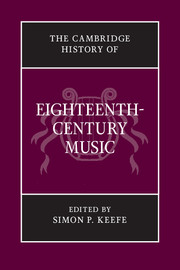Appendix II - Institutions in major European cities
Published online by Cambridge University Press: 28 March 2011
Summary
Berlin
Sacred The principal churches supporting sacred music were the Petrikirche, Nikolaikirche and Marienkirche; others, including the Schloss- und Domkirche (completed 1750), Parochialkirche, Sophienkirche, Neue Kirche, Garnisonkirche and the Catholic Hedwigskirche (1773) maintained more modest establishments.
Opera The Königliches Opernhaus, commissioned by Frederick the Great and designed by Knobelsdorff, opened in 1742. Its ensemble included famous singers from Italy, with the repertory dominated by Hasse and the operas of the court Kapellmeister C. H. Graun. After the Seven Years’ War the house re-opened in 1764, but the fortunes of the Italian opera declined thereafter. In the late 1770s C. T. Döbbelin began presenting singspiel, and in 1786 his troupe moved to the French Theatre (renamed the Nationaltheater) with a royal subsidy. Until the end of the century the National theater specialized in German opera, while the royal theatre maintained the tradition of opera seria.
Court The Elector of Brandenburg, Friedrich III declared himself King of Prussia in 1701. Initially encouraged in musical pursuits by his wife Sophie Charlotte, Friedrich maintained a court orchestra of approximately thirty players. Friedrich was succeeded by his son Friedrich Wilhelm I in 1713, after which the ensemble was almost disbanded. With the accession of Friedrich II (Frederick the Great) in 1740, the orchestra was re-established and music became an integral part of daily life at the court. The king was an enthusiastic flautist and employed distinguished musicians including Quantz, C. P. E. Bach and F. Benda.
- Type
- Chapter
- Information
- The Cambridge History of Eighteenth-Century Music , pp. 709 - 724Publisher: Cambridge University PressPrint publication year: 2009

